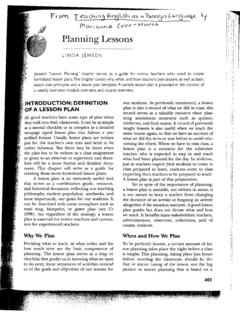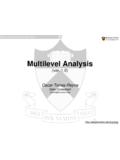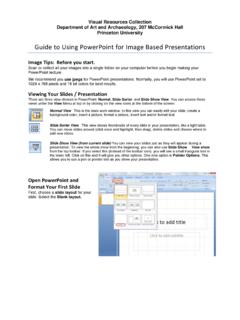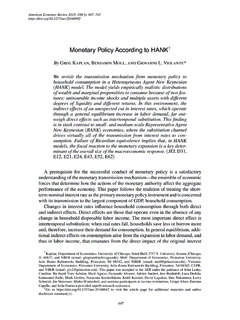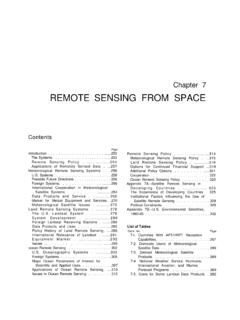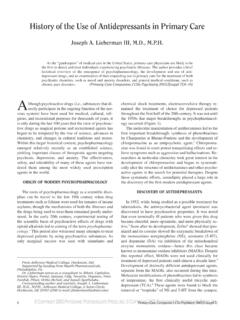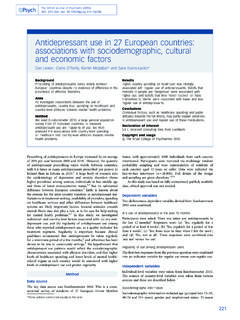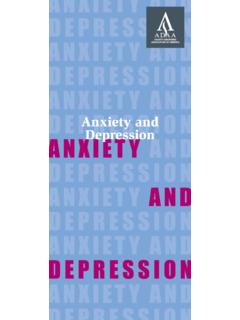Transcription of ONLINE FIRST Antidepressant Use During Pregnancy and ...
1 ONLINEFIRSTORIGINAL ARTICLEA ntidepressant Use During Pregnancy andChildhood Autism Spectrum DisordersLisa A. Croen, PhD; Judith K. Grether, PhD; Cathleen K. Yoshida, MS; Roxana Odouli, MSPH; Victoria Hendrick, MDContext:The prevalence of autism spectrum disorders(ASDs) has increased over recent years. Use of antide-pressant medications During Pregnancy also shows a secu-lar increase in recent decades, prompting concerns thatprenatal exposure may contribute to increased risk of :To systematically evaluate whether prena-tal exposure to Antidepressant medications is associatedwith increased risk of :Population-based case-control study. Medicalrecords were used to ascertain case children and controlchildren and to derive prospectively recorded informa-tion on mothers use of Antidepressant medications, men-tal health history of mothers, and demographic and medi-cal :The Kaiser Permanente Medical Care Pro-gram in Northern :A total of 298 case children with ASD (andtheir mothers) and 1507 randomly selected control chil-dren (and their mothers) drawn from the membershipof the Kaiser Permanente Medical Care Program in North-ern Outcome :Prenatal exposure to Antidepressant medica-tions was reported for 20 case children ( ) and 50control children ( ).
2 In adjusted logistic regressionmodels, we found a 2-fold increased risk of ASD associ-ated with treatment with selective serotonin reuptake in-hibitors by the mother During the year before delivery(adjusted odds ratio, [95% confidence interval, ]), with the strongest effect associated with treat-ment During the FIRST trimester (adjusted odds ratio, [95% confidence interval, ]). No increase in riskwas found for mothers with a history of mental healthtreatment in the absence of prenatal exposure to selec-tive serotonin reuptake :Although the number of children exposedprenatally to selective serotonin reuptake inhibitors inthis population was low, results suggest that exposure,especially During the FIRST trimester, may modestly in-crease the risk of ASD. The potential risk associated withexposure must be balanced with the risk to the motheror fetus of untreated mental health disorders.
3 Further stud-ies are needed to replicate and extend these Gen Psychiatry. 2011;68(11) ONLINE July 4, SPECTRUM DISOR-ders (ASDs) are neurode-velopmental disorders thatare evident in early child-hood and characterized bypervasive impairments in social interac-tion and communication and by re-stricted and stereotyped patterns of be-havior. Data from twin and family studiessuggest a strong genetic component in theetiology of autism,1-4and results from neu-ropathology and brain imaging studies pro-vide evidence for dysregulation in nor-mal brain development During the prenatalor early postnatal ,6 Since the firstepidemiologic survey was conducted in1966,7the reported prevalence of autismhas increased dramatically, from 4 to 5cases per 10 000 population in 1966 to ap-proximately 100 cases per 10 000 popu-lation (1%) ,9 While at least someof this observed increase in prevalence canbe attributed to changing diagnostic stan-dards, availability of services, and greaterpublic awareness, there is considerable sci-entific and public concern about environ-mental factors that may contribute to au-tism risk, most likely in interaction withgenetic the numerous secular trendsthat have occurred During the period of therecognized increase in autism prevalenceis an increase in the use of antidepressantmedications During Pregnancy : from arange of approximately 1% to 6% inthe early to mid-1990s to as high as 7%to 13% in more recent ontheir efficacy and superior safety profile,selective serotonin reuptake inhibitorsSee also page 1093 Author Affiliations.
4 Division ofResearch, Kaiser PermanenteNorthern California, Oakland(Dr Croen and Mss Yoshida andOdouli), Environmental HealthInvestigations Branch,California Department of PublicHealth, Richmond(Dr Grether), and Departmentof Psychiatry, NeuropsychiatricInstitute and Hospital,University of California,Los Angeles (Dr Hendrick).ARCH GEN PSYCHIATRY/VOL 68 (NO. 11), NOV 2011 American Medical Association. All rights From: by a Princeton University User on 03/25/2014(SSRIs) have become the FIRST -line treatment for depres-sion and other psychiatric conditions, including anxi-ety and obsessive-compulsive disorders. Selective sero-tonin reuptake inhibitors and other antidepressantmedications cross the placenta10-12and are secreted inbreast milk,12,13thus raising concerns about adverse ef-fects from fetal and infant exposure. Atypical serotoninpatterns in blood specimens obtained from individualsdiagnosed with ASD and their family members have beenconsistently reported from multiple studies,14but the un-derlying biologic pathways that may link serotonin in pe-ripheral blood with phenotypic expression of ASD re-main to be elucidated.
5 As called for in a recent article byHadjikhani,15systematic study of ASD and prenatal ex-posure to SSRIs and other Antidepressant medications isclearly needed. To our knowledge, no prior studies haveaddressed this important evaluating prenatal Antidepressant exposureand other pediatric outcomes, such as major congenitalmalformations12,16-19and other adverse obstetric or neo-natal outcomes, have shown weak and inconsistent ,18,20-22 Poor neonatal adaptation has been re-ported for exposure late in ,23,24 Directlyrelevant to concerns about a possible association withASD, very few studies have evaluated the possible ef-fects of prenatal exposure on longer-term outcomes, suchas milestone achievement, cognitive skills, and behav-ioral outcomes. Although the majority of such studies havefound no difference between prenatally exposed and un-exposed children, some reports indicate possible subtleeffects on motor development and control25and differ-ences in reaching studies usingrodent models indicate that transient inhibition of theserotonin transporter with the SSRI fluoxetine hydro-chloride During early brain development has conse-quences for some measured behaviors later in ,28 Evaluation of fetal exposure to SSRIs and other antide-pressant medications as a potential risk factor for ASD andother neurodevelopmental conditions is complicated by thedifficulty in distinguishing the effects of medication expo-sure from the effects of the underlying condition that ledto treatment.
6 Making this distinction is especially impor-tant for the study of autism because a prior history of psy-chiatric disorders, including depression, has been re-ported to be more common among mothers of infants laterdiagnosed with autism than among mothers of unaffectedchildren, suggesting an underlying, preexisting conducted a large, population-based case-control study with prospective ascertainment of mothers prescription drug use and history of mental health disor-ders to investigate the association between antidepressantuse by mothers During Pregnancy and subsequent diagno-ses of ASDs in study sample was drawn from the Childhood Autism Peri-natal Study, a large case-control study of prenatal, perinatal, andneonatal risk factors for ASDs set within the Kaiser PermanenteMedical Care Program in Northern California (KPNC), whichis a large integrated health care organization that provides carefor more than million residents and approximately 25% ofbirths in 14 northern California counties.
7 Except for the lowestand highest income earners, the KPNC membership is repre-sentative of the total population in the of case and control selection have been described , all infants born at a KPNC facility between Janu-ary 1995 and June 1999 and who remained health plan mem-bers for at least 2 years following birth were eligible for inclusion(n=88 163). On the basis of theInternational Classification of Dis-eases, Ninth Revision, Clinical Modification(ICD-9-CM), chil-dren with at least 1 diagnosis of autism (ICD-9-CMcode ),Asperger syndrome (ICD-9-CMcode ), or pervasive devel-opmental disorder not otherwise specified (ICD-9-CMcode )recorded in the KPNC outpatient clinical databases between Janu-ary 1995 and November 2002 were considered case children(n=420). Previous studies, which we have conducted within theKPNC health care system, indicate a high level of diagnostic va-lidity for these case ascertainment without an ASD diagnosis were randomly sampledfrom the remaining cohort of live births at a ratio of 5 controlchildren per 1 case child.
8 Control children (n=2100) were fre-quency matched to case children by sex, birth year, and hos-pital of we were interested in examining characteristics ofthe mother in relation to autism risk in the offspring, we re-stricted the analysis to 1 child per mother, selecting the casechild for women with both a case and a control child in theoriginal study sample and randomly sampling 1 child for in-clusion for other women with 2 case or control children (13case mothers and 5 control mothers). We further restricted thesample to children (73% of initial cases and 72% of initial con-trols) whose mothers were KPNC members with full phar-macy benefits in the year before delivery (ie, 3 months prior toconception and During each trimester of Pregnancy ), and weexcluded 16 controls whose medical records contained an ASDdiagnosis recorded after initial control selection. The final ana-lytic file included all remaining cases and controls from the origi-nal study inpatient and outpatient prescriptions for antidepres-sants dispensed at a KPNC pharmacy in the 3 months beforethe last menstrual period (LMP) through the date of deliveryof the study child were identified from the Pharmacy Informa-tion Management System.
9 Antidepressants were classified as(1) SSRIs (citalopram hydrobromide, fluoxetine, fluvoxaminemaleate, paroxetine hydrochloride, and sertraline hydrochlo-ride); (2) dual-action antidepressants (nefazodone hy-drochloride, trazodone hydrochloride, and venlafaxine hy-drochloride), including serotonin-noradrenergic-reuptakeinhibito rs, noradrenergic and specific serotoninergic antide-pressants, and noradrenaline-reuptake inhibitors; and (3) tri-cyclic antidepressants (amitriptyline hydrochloride, desipra-mine hydrochloride, doxepin hydrochloride, imipraminehydrochloride, nortriptyline hydrochloride, and protriptylinehydrochloride).In the year before delivery, 4 exposure times were defined:preconception (3 months prior to the estimated LMP), FIRST tri-mester ( FIRST 90 days after the LMP), second trimester (91-180days after the LMP), and third trimester (181 days after the LMPto date of delivery).
10 The date that the prescription was dis-pensed and the number of days for which the medication wassupplied were used to determine exposure status During eachtime period. Exposure to antidepressants During a given timeperiod was assumed if a prescription was dispensed During thattime period or if the number of days for which the medicationwas supplied overlapped some portion of the time were considered unexposed if they had no dis-pensed Antidepressant prescriptions and no supply overlap dur-ing the entire time period from 3 months prior to the LMPthrough the date of delivery. The estimated LMP was as re-ARCH GEN PSYCHIATRY/VOL 68 (NO. 11), NOV 2011 American Medical Association. All rights From: by a Princeton University User on 03/25/2014corded in the medical records for women with regular men-strual periods and if in 7-day agreement with a FIRST trimesterultrasonography; for other women, the estimated LMP was de-rived from a FIRST trimester address the analytic concern about treatment vs under-lying condition for which the treatment was prescribed, themothers psychiatric conditions diagnosed at any time preced-ing delivery were identified from inpatient and outpatient da-tabases.


